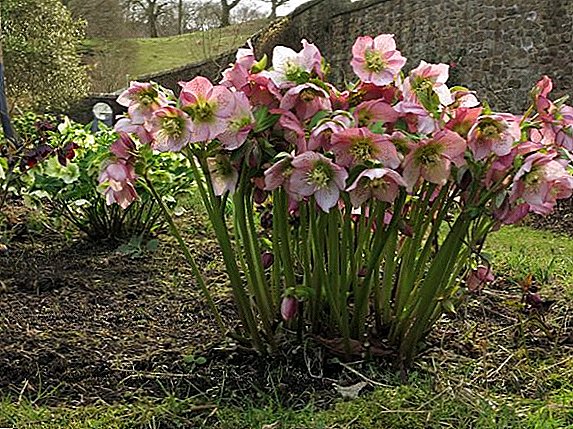
In its beauty Tiger Lily ranks second after roses.
It is a symbol of hope, freedom and purity.
Has gained widespread use in gardening. Can grow at home.
general description
In the wild, the plant has become widespread in Japan, China, Europe. In the Russian Federation is found on Sakhalin, the central black-earth part of the country, the Kuriles and Primorye.
Sometimes the flower is called "herbaceous" or "lanceolate perennial." Tall flower reaches more than 1.5 meters.
It has a creeping root system. Has a miniature oval bulbs snow white. The stem of the plant is straight, cylindric, brown.
It has a small snow-white felt pubescence. The leaves of the flower are lanceolate. In the boxes at the base of the stem, miniature oval bulbs of black color are formed.
Visually see the Tiger Lily in the photo below:




Home care
Consider how to care for tiger lily.
Bloom
Flowers stalky, very large. In diameter reach 7-9 cm. The main color is bright orange.
Some hybrids can be pink, red, golden hue. The flowers have small purple blotches. Flowers have a pleasant delicate floral aroma.
Also, some forms of the subspecies may be terry. They have small soft fibers.
On palpation, they resemble natural velvet or velor. Terry flowers have different shades. But they don't smell.
Holding up more 20-25 days. If not enough good conditions can last 6-8 days. After flowering fruit box is formed.
Pruning
After flowering is necessary cut dried flowers.
ATTENTION! In summer, you can not trim the leaves. They need a flower for photosynthesis.
In late August, the plant must begin to prepare for the winter. To do this, cut off the stem. There should be a stump equal to 8-10 cm.
Planting and transplanting
 In open ground, plant a flower should be on an elevated site. At home, use wide and deep containers. Soil should be light and loose.
In open ground, plant a flower should be on an elevated site. At home, use wide and deep containers. Soil should be light and loose.
It is necessary that the soil was with a slightly acid or neutral reaction. Drainage must be placed on the bottom of the pot. Pebbles, expanded clay or broken shards can be used.
Bushes are planted in the middle of the tank. Depth of landing should not exceed 5 cm. Width should be equal to 10 cm.
It is better to plant one bush in one pot. When transplanting, you can use the scaly method of reproduction.
Temperature
Plant prefers warm temperate climate. Grows actively at temperature 19-26 ° C.
IMPORTANT! At home, it is not recommended to place containers with a flower near heating appliances. In this case, the humidity of the air will be dry. The plant will have to be sprayed daily with water from a sprayer.
Watering
If the flower grows on the west or north side, it is almost does not need. In hot weather with abundant sunshine, for active formation will require moderate systematic irrigation.
They are best carried out in the morning or afternoon, so that over the day excessive moisture can evaporate. After flowering, the procedure should be gradually reduced. To hold the water, you can use pallets with wood moss or sawdust.
Lighting
The chosen place for the growth of bushes should be well protected. With a lack of light, the plant will not form. Growth will slow down a lot. Lilies bloom only in good light. Therefore, they are recommended to grow in bright spacious rooms.
Growing up
 The plant goes well with phlox, gladioli, asters, ferns. Can grow next to ornamental, herbaceous or deciduous plants.
The plant goes well with phlox, gladioli, asters, ferns. Can grow next to ornamental, herbaceous or deciduous plants.
At home, it is actively formed in wide containers without thickening. The subspecies is ideal for cutting and forcing. Suitable for growing house in wide tanks, in open ground on garden plots or greenhouses.
Breeding
Tiger lily can be propagated different ways:
- Pokolukovichny method - leads to a strong thickening of the bushes. It must be carefully controlled. Collect planting material in late summer - early autumn. It is recommended to plant onions on previously prepared fertile soil. It is best to use wide tanks. Full rooting of the plant occurs in mid-autumn. Lily tolerates wintering safely. If the flower grows in open ground, then in cold regions in severe winters it is recommended to mulch the beds. They are covered with a thick layer of foliage.
- Another breeding method - sowing seeds. With such a landing thickening does not occur. But it is worth considering that the germination rate of such material is below 70%.
- Breeding scales can be combined with transfers of flower bushes. But this process is very troublesome. Small scales should be separated from the mother bulb. The cuts are carefully sprinkled with pesticide deactivated coal powder. The resulting planting material must be kept in a greenhouse at a temperature 21-24 ° C. Full formation occurs during 60-90 days. Substrate should be hydrated. Perfectly sawdust or forest moss. The scales are planted in special tanks in the middle of spring. Flowering plants will come 2 or 3 years after landing.
Fertilizer
Unlike other subspecies of lilies, this representative of the flora in the mandatory feeding does not need. But with good care, you can use compost.
Fertilizer is brought under digging when planting or transplanting bushes. Also allowed the use of complex or mineral fertilizers.
Medicinal properties
What are the healing properties of tiger lily?
 Flowers and bulbs of this representative flora are used in traditional medicine. They make various preparations, natural decoctions, which tone up pressure.
Flowers and bulbs of this representative flora are used in traditional medicine. They make various preparations, natural decoctions, which tone up pressure.
They can also be used for colds, as they have an expectorant effect. Folk preparations of lilies are hemostatic and painkillers.
Therefore, they can be used for deep cuts, wounds, sharp pains. Usually decoctions are used in the treatment of abscesses, heart diseases, lung diseases, to restore the nervous system or to improve appetite.
The active components of this plant are part of "Mastodinona". This medicine is considered the best natural drug. It easily relieves pain during the menstrual cycle and mastopathy.
In the East, as a seasoning flowers are used plants. They are dried and added to various national dishes. The bulbs are boiled in milk or consumed raw.
IMPORTANT! Cats should not be allowed to ingest the Tiger Lily. This plant has a strong toxic effect on these animals!
Diseases and pests
Plant exposed aphids, leaf beetles, lily flies, thrips, as well as scoops and wobblers.
This representative of the flora can get sick with rust, gall tumor, gray rot and Fusarium. As a preventive measure, leaflets should be sprayed with pesticides.
IMPORTANT! This representative of the flora is a carrier of the Mosaic virus. Such a lily poses a serious threat to the rest of the subspecies of flowers. They may appear characteristic blotch on the flowers or leaves. But the virus does not affect the growth of the Tiger lily.
Tiger lily is a beautiful bright plant with a pleasant floral scent. It has many varieties. Can grow at home in deep pots, in greenhouses or on garden plots. Loves moderate watering, abundant sunshine. In the mandatory dressing does not need.












